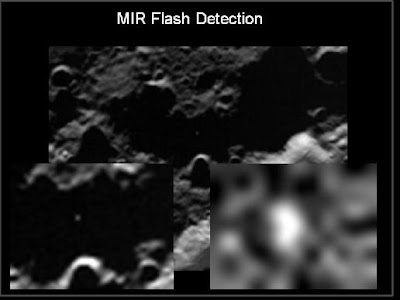 LCROSS impact crater as viewed with near-infrared (NIR) and ultra violet/visible (UV/Vis) spectrometers. Credit NASA Ames.
LCROSS impact crater as viewed with near-infrared (NIR) and ultra violet/visible (UV/Vis) spectrometers. Credit NASA Ames.At approximately 4:31 a.m. PDT on Oct. 9, 2009, the LCROSS Centaur impacted the surface of the Cabeus crater. From approximately 373 miles (600 km), the LCROSS Shepherding Spacecraft captured the impact flash with its instruments. The faint but distinct flash was only a few pixels wide in the LCROSS cameras and lasted only a brief moment but will yield valuable information about the composition of the material at the impact site.
 The LCROSS mid-infrared (MIR) Camera detected a sodium flash at Centaur Impact. Credit NASA Ames.
The LCROSS mid-infrared (MIR) Camera detected a sodium flash at Centaur Impact. Credit NASA Ames.
No comments:
Post a Comment